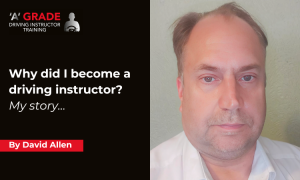Brief outline of Lesson Planning on a driving lesson
Hi, this a brief and to the point description of lesson planning.
OK, let’s start with the most important bit, finding out your pupil’s needs and prioritising them.
To explain this let’s show you a few examples of identifying your pupils needs.
In the first example, you are dealing with new pupil. The best ways to identify your pupils is by asking them a number of questions either on the phone when they decide to book driving lessons with you or on their first lesson.
After your initial introduction the questions would be how many driving lesson you have done so far. If the answer is zero, the lesson will be on a very quiet road, doing the basics like clutch control, moving off & stopping, gear changing etc
If they have already had a number of lessons or a driving test, you would need to ask a few other questions. You could ask them what roads they have driven on, what they found easy to do and what they didn’t find easy to do.
You are trying to find out their level of ability and experience. I never fully trust what the pupil says, as a few in the past have over-estimated their ability to drive. These are the pupils who want to attempt a driving test before they ready. The best of luck on how you deal with them!
Normally, with pupils with some experience, I get them to drive, normally starting on quieter roads and possibility progressing to busier more complex ones (if they are capable) to assessment their needs. This takes maybe 10 to 15mins.
With your existing pupils who have had a number of lessons with you, your goals next lesson is generally set at the end of the last one. This can be based around, what went well, what didn’t do well and what you need to improve. Remember, not to miss any of your pupils’ learning needs by watching their actions, body language and what they are saying throughout the lesson.
The most effective way to start is to think of the trainee’s needs and their current level of ability, knowledge and skill. Then ask yourself a series of questions involving what, why, how, where and when. This is best done by holding a conversation with your pupil and asking them a few questions
What do you already know?
What are you going to need to learn?
What do you need to have included?
How do you going to get the message across?
Where will we need to go to carry out the lesson in an appropriate environment?
The goal should be set should be SMART (specific, measurable, achievable, relevant and timed). Generally, the best goals are set by the pupil, but as mentioned above, some pupils are not aware of what skill they need to more capable in, some you might need to suggest a goal for them, based on previous incidents or situations or because you are constantly helping to manage the risk when completing a task. (remember we are always aiming for your pupil to be independent, without input from us).
After agreeing the SMART goal for the session, you would need to structure the learning. I have used three different types of structure in the past. This is either the GROW model (Goal, Reality, Options, Way Forward), SEDSS (Scaling, Evidence, Development, Support and Success) or OSKAR (Objective, Scaling, Know-How, Action & Affirm and Reflection). OSKAR is my favourite!
Learning is so much effective if you follow a structure, think about structured systems in driving like MSPSL, LADA, POM and IPSGA and how they make driving more effective.
Remember this a very basic outline of lesson planning. Lesson planning is essentially vital to delivering a good lesson. There are many different skills that are required to plan a lesson. To be more proficient in lesson planning you need proper structured training with an ADI Trainer. Knowing is not enough, you must apply (Quote from Bruce Lee!)

